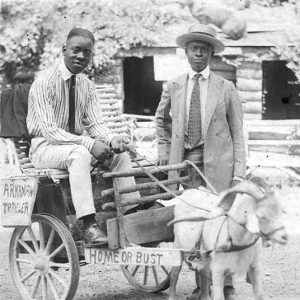calsfoundation@cals.org
Happy Hollow
aka: McLeod's Amusement Park
McLeod’s Amusement Park, more commonly known as Happy Hollow, served as one of Hot Springs’s most popular tourist attractions from the late 1800s until the 1940s. It was located at the head of Fountain Street, just off Central Avenue, and north of Hot Springs Mountain.
Photographer Norman McLeod owned and operated Happy Hollow from the time of its founding through 1908. McLeod, who was born in Georgia, became a wanderer after his college days, when he came to Hot Springs (Garland County) in 1888 and established his business. Happy Hollow began as a picture studio. The amusement park complex gradually developed from McLeod’s vision. He owned Happy Hollow until 1908, when he sold the property to Dave Anselberg. T. E. Davis was listed as the proprietor of the park in the 1921 city directory, and Benjamin Unsell was listed in the 1940 city directory under the same title. Today, all that remains are the Happy Hollow Springs on the southeast slope of North Mountain. Happy Hollow Motel, located at 230 (later 231) Fountain Street, preserves the name.
The park contained a shooting gallery, a zoo, and a souvenir shop. The shooting gallery was located on the side of the mountain, where a shelf held targets made of bottles. The park’s zoo held fifty animals, while additional uncaged animals, such as burros, ponies, and horses, roamed the park for adults and children to ride.
The park was best known for its humorous photographs. Happy Hollow’s visitors could have their pictures made in an old bathtub, riding on the back of a burro, or taking a drink at the bar, which contributed to Arkansas’s hillbilly image. Painted scenery such as a hot air balloon, a jailhouse, and a gigantic angry bear served as backdrops for additional images. Other amusing pictures could be taken with models of cowboys, clowns, and other humorous vignettes. Visitors placed their heads where the models’ heads should have been to pose for the pictures.
Photographs were not the only fun attraction at Happy Hollow. Every day a burro-drawn streetcar carried visitors down Central Avenue to Happy Hollow. A slight grade on the trip often made it difficult for the burro. One day, the burro became tired. When he was unhitched from one end of the car and waiting to be re-hitched to the other end, he jumped aboard the rear platform and refused to move. The donkey amused visitors and became an instant attraction. From that day forward, the donkey made each return trip in grand style.
The site of McLeod’s Amusement Park was known as Happy Hollow before the park was created. African Americans living in the mountains around the 1870s ventured down to the springs to do their wash, and as they worked, they sang songs of praise. They held frequent revivals in the hollow in addition to Sunday worship services. These meetings served as some of the community’s earliest religious meetings. Because of the rejoicing that took place, the vale became known as Happy Hollow.
McLeod and Happy Hollow were nationally known. Famous visitors to the park included Billy Sunday, Carry Nation, and Al Capone.
For additional information:
House, Boyce. “Arkansas Boyhood, Long Ago.” Arkansas Historical Quarterly 20 (Spring 1961): 172–181.
Hudgins, Mary D. “Norman McLeod and His Happy Hollow.” The Record 10 (1969): 27–30.
Scully, Francis J. Hot Springs, Arkansas and Hot Springs National Park. Little Rock: Hanson Co., 1966.
Terry, Jessie Gantt. “Happy Hollow.” The Record 22 (1981): 81–84.
Brook Pierce
Ouachita Baptist University















Comments
No comments on this entry yet.